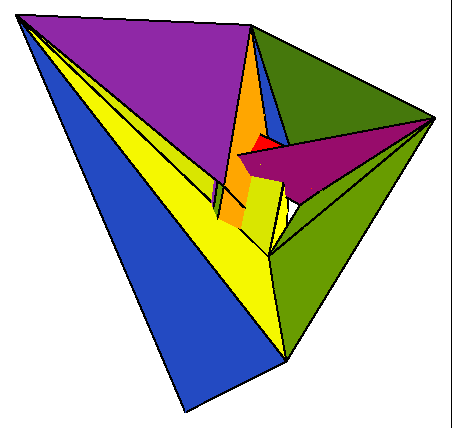
Vertices: Faces:
a = (-2,0,0) abk bgk bgj bij gfj
b = (0,0,0) adl akl cdl flm clm
c = (1,0,0) hij ehi bci cim fim
d = (0,1,0) efi hkl hjl fjl ghk
e = (-2,-1,2)
f = (1,-1,2) abe bef bcf cfg
g = (1,1,2) cgh cdh adh aeh
h = (0,3,2)
i = (-3/8,0,1/2)
j = (1/2,1/4,1)
k = (-1/4,7/12,7/6)
l = (0,3/4,7/6)
m = (1/4,0,1/2)
A view of this surface is given below. In this picture, the
x-axis is toward the top right, the y-axis is toward the
upper left corner, and the z-axis is out from the page (so, for
example, vertex a is near the bottom center of the page, and
vertex h is in the upper left). Additional pictures are
available.
![[More]](pix/Link.gif)

To see that this is really the projective plane with one handle, we compute the Euler characteristic: since there are 13 vertices, 42 edges, and 28 faces, the Euler characteristic is V - E + F = -1, as desired. Another way to see this is from the triangulation shown below, which shows the real projective plane (left) with two disks removed (grey) together with the tube that connects the two holes (right). The dotted line represents the self-intersection.
To see that it is an immersion, we need to check that the
star of each vertex is embedded
![[More]](pix/Link.gif) .
This can be seen in the triangulation above, since the
double locus does not contain any
vertex. As expected, its image is the
wedge of three circles, their
common point forming the required
triple point
in the immersion
.
This can be seen in the triangulation above, since the
double locus does not contain any
vertex. As expected, its image is the
wedge of three circles, their
common point forming the required
triple point
in the immersion
![[More]](pix/Link.gif) .
.
To check that it is tight, one must show that all the edges of the
convex hull
are contained in the surface itself, and that any vertex
that is not a vertex of the convex hull of the surface lies inside the
convex hull of its neighbors
![[More]](pix/Link.gif) .
.
To check these conditions, note that the convex hull of the surface is formed by 7 vertices (a, c, d, e, f, g, h), and the last 8 faces listed above contain all the edges of the convex hull. Of the remaining 6 vertices, two lie on the straight line segment between two neighbors (b lies on the segment ac, k lies on the segment ag), two lie within a triangle formed by three neighbors (i lies within triangle beh, and j within bfg), and two lie inside tetrahedra formed by four neighbors (l lies within acfh, and m lies within cfil).
The
level sets
for the
height function
in the direction of the z-axis closely resemble those
originally given by Kuiper in
[K2],
where he describes a tight real projective plane with two handles.
![[More]](pix/Link.gif)
The situation for
smooth
versions of the projective plane with a handle is markedly different;
in fact, no tight immersion is possible in the smooth case
![[More]](pix/Link.gif) .
This polyhedral example is significant in that it represents one of
only a handful of low-dimensional examples where the smooth and
polyhedral theories differ in a significant way. The circumstances
that provide for the difference in this specific case still deserve
investigation, and should be a source of insight into both areas of
study.
.
This polyhedral example is significant in that it represents one of
only a handful of low-dimensional examples where the smooth and
polyhedral theories differ in a significant way. The circumstances
that provide for the difference in this specific case still deserve
investigation, and should be a source of insight into both areas of
study.
![[More]](pix/Link.gif)
![[Right]](pix/Right.gif) Pictures of the polyhedral surface
Pictures of the polyhedral surface
![[Left]](pix/Left.gif) The smooth solution
The smooth solution
![[Up]](pix/Up.gif) Introduction
Introduction
7/19/94 dpvc@geom.umn.edu --
The Geometry Center